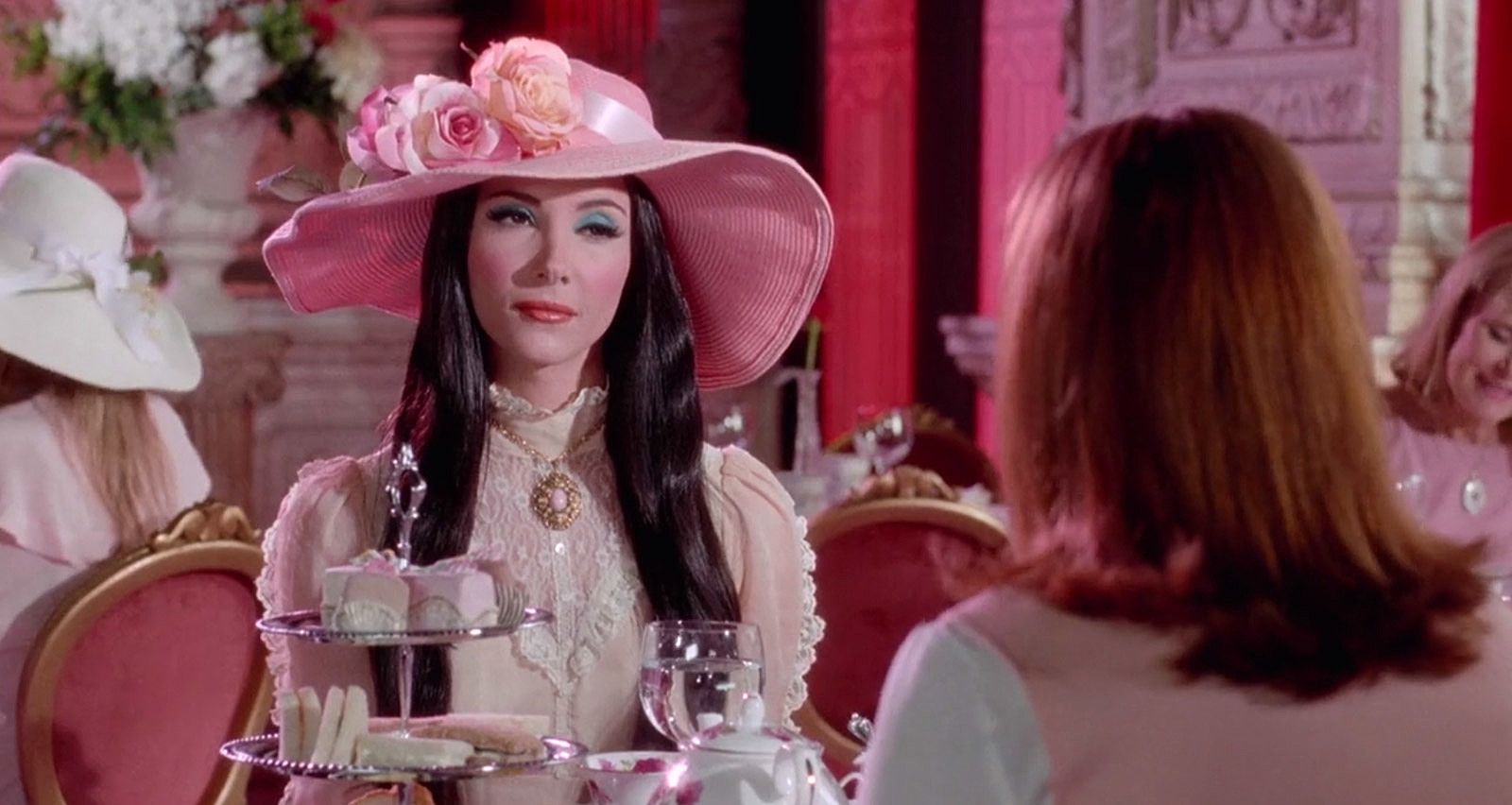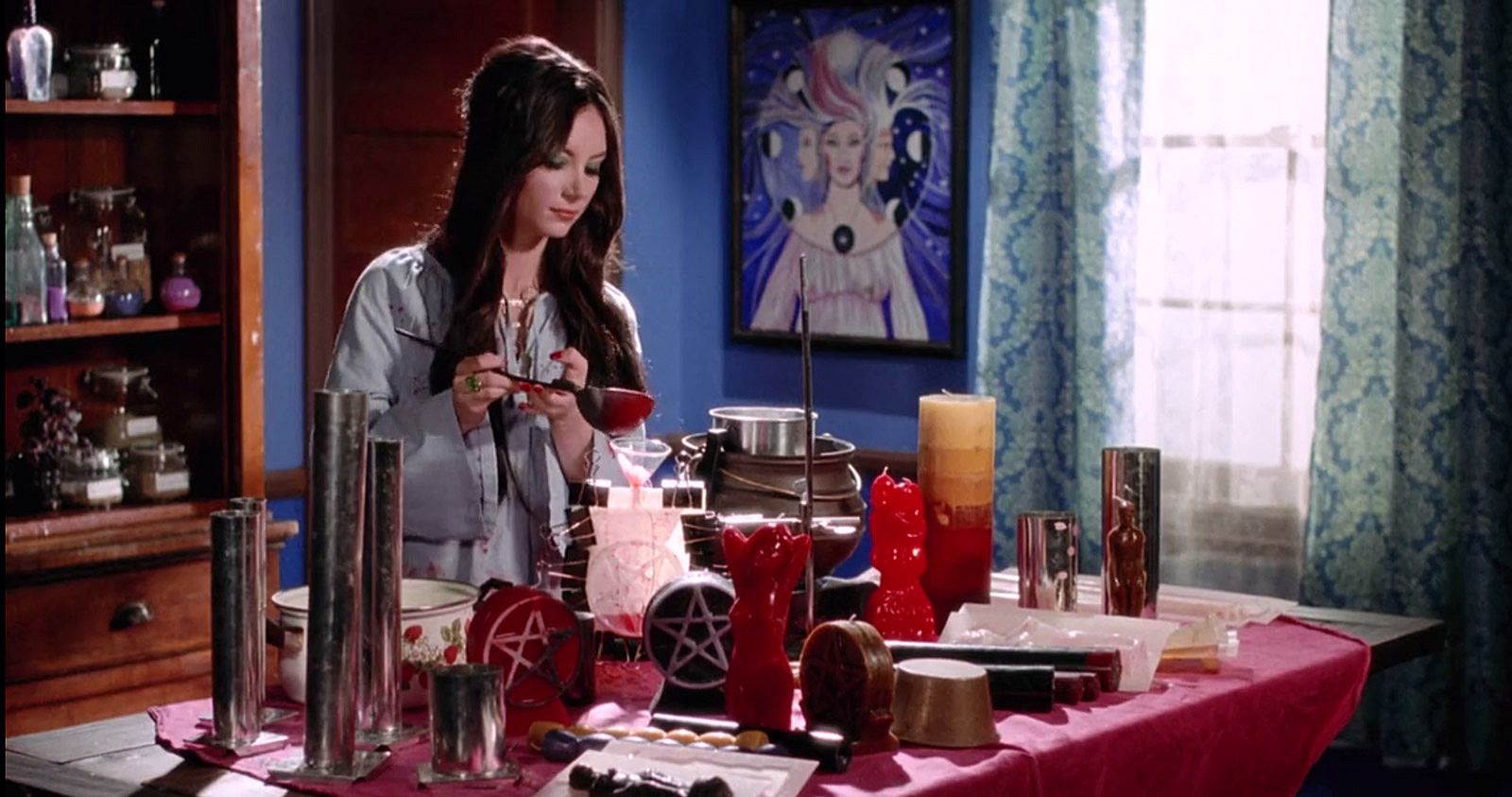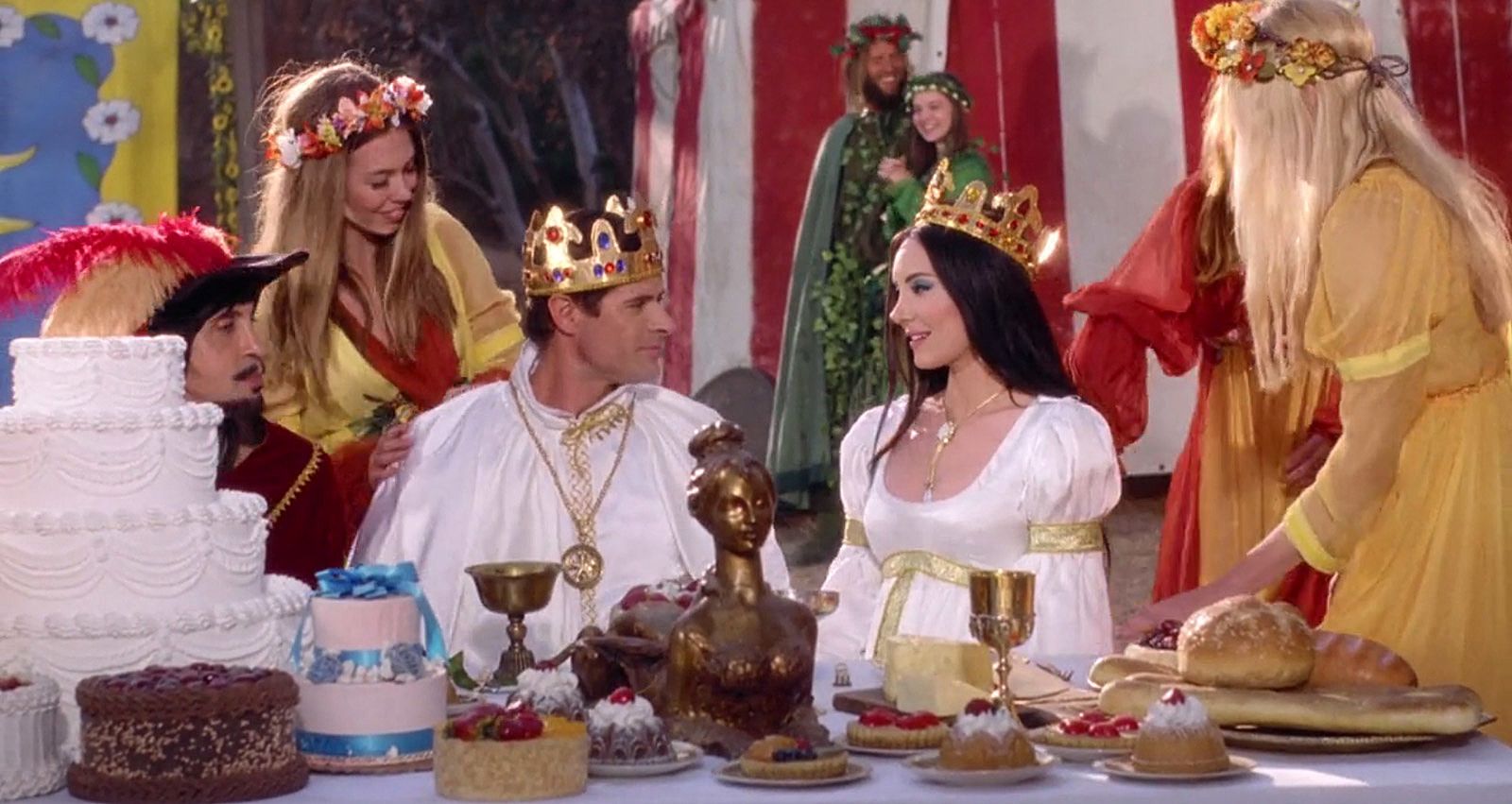Satire, Sincerity and Pastiche: A Review of The Love Witch
Erin Harrington takes a look at what we can read into the smash-hit The Love Witch - even despite the director's protestations.
Erin Harrington digs deep into what we can take away from The Love Witch's very deliberate, very distinctive - but supposedly very misunderstood - aesthetic and values.
Anna Biller’s retro, occult melodrama The Love Witch follows the murderous exploits of the titular love-lorn witch, Elaine, as she constructs herself as men’s ultimate fantasy in the hope that they might repay her with their unending devotion.
This devotion is a conversion – in theory, at least – of sex into love, but Elaine doesn’t quite account for the fact that the men around her (and, by the film’s troubling logic, perhaps all men) are incapable of surviving the experience of such strong emotion. The film has been praised widely and effusively as a triumph of pastiche and an homage to pulp; a stylised, tragicomic and anachronistic yet archly feminist take on (s)exploitation and horror that both courts and decentres the male gaze of classical Hollywood cinema through its emphasis on a parodic, Vaseline-lensed hyper-femininity. It’s Bewitched by way of Hammer Studios, perhaps, for the age of Trump.
What’s particularly interesting, though, is that this broad take on the film is one that sits at odds with Biller’s own account of the film. In recent interviews she remarks that these comparisons are insulting and damaging because they diminish the film and the character, and that viewers’ focus on the film’s art direction is dismissive of the film’s message. In short, the interpretation of the film as a satirical and affectionate send-up is a misunderstanding that ignores a serious, tragic, and utterly unironic story.
In that case, how are we to think about a film so utterly shaped by nostalgia, the history and iconography of objectification and a type of cinematic fetish, when the difference between a sly wink and playing it straight is so slim as to be almost negligible? Can the aesthetic of a film like this really be apolitical? And, when The Love Witch so clearly mingles (or seems to mingle) the gorgeous with the garish and the knowing with the naïve, how can we tell who the joke is on – or if there’s even a joke at all? Like the artfully designed Rider-Waite-Smith tarot pack that Elaine regularly consults, the film offers rich and compelling imagery but also a curious sense of murky ambiguity that lets us see what we want to while also revealing things that we didn’t realise were there.
Cinematically, the film itself is an idiosyncratic, woozy, shimmering wonder – a passion project pieced together by Biller over longer than seven years. Its vibrant, eye-popping Technicolour palette and its slightly off-centre, artificial sense of time, space and movement feels a little like the opening of Gentlemen Prefer Blondes after a few too many shots of absinthe. Biller’s determined auteurship has been foregrounded extensively, including on her own blog, where she writes about the obsessive, almost devotional making of the film: designing and sewing the costumes; selecting tea sets and items for set dressing; creating a detailed altar based on specifications outlined by legendary English occultist and magician Aleister Crowley; writing and arranging various songs; painting the art that hangs on the walls; binding spellbooks and calligraphing spells. The film is utterly, delectably handmade.
The very craft is evident, and here I refer not only to film-making but an emphasis upon the sorts of bespoke handcrafts associated with female and feminine art practice (and often denigrated or dismissed because of their decorative nature and domestic focus). It’s one thing to obsessively construct a world, but another entirely for the film’s creator to spend months making a large Persian wool-hooked rug by hand. As Biller writes , “I always make something very time-consuming with my hands for each film, in order to develop a personal relationship to the objects.” This personal, tactile, embodied and analogue relationship is one that blurs the line between art direction and interior design, and ritual itself. Much of the film’s aesthetic appeal is a slow-movement antidote to readymade; there’s a sense of eroticism in the film’s materiality, just as there is in the lush mise en scène. It’s ironic, almost painful, that this singular attention to detail has resulted in a film that, in the eyes of the director, has been widely misread.
So where might this disconnect come from? The film’s sense of materiality is inextricably linked to its sense of time and history, and this is where things get tricky. Beyond the retro costumes, hair and makeup, the characters drape themselves in the trappings of the past, even while they reach for their cellphones or stand in front of late-model BMWs.
It’s one thing to obsessively construct a world, but another entirely ... to spend months making a large Persian wool-hooked rug by hand.
The film’s anachronisms give the impression that all those around Elaine are trapped within a great, mind-altering fog of regressive nostalgia. As they sip tea and nibble tiny cakes in an outrageously camp, all-pink women’s-only tea room, British interior decorator Trish – whose husband will become one of Elaine’s victims – declares effusively how much she loves Victoriana. Wayne, a horny corduroy-clad English professor, teaches nineteenth-century English and French literature, while one of his adoring, moon-eyed students clutches a book of Lord Byron’s poems to her chest. Elaine and her later love interest, police detective (and well-muscled Ken doll) Griff, stumble across a Renaissance Faire event and have a fake Medieval wedding; this event is repeated near the end of the film, framing it as the apotheosis of Elaine’s romantic fantasies. Griff later calls her a Stepford Wife, forgetting, perhaps, that those wives were not monsters themselves, but were created by monstrous men. Even the witches who form the local coven are nostalgic: for the Summer of Love, for the counterculture, and for a time when witchcraft was ‘looser’. Each character looks broadly to historic notions of pleasure, which combine to form a rigid espalier of desire.
It doesn’t help, though, that pastiche is currently the postmodern language of choice. Complex combinations of historic styles – here of editing, of lighting and mise en scène, of music, of characterisation and performance, and so on – are used both for their own aesthetic value and to gesture to forms and concerns of the past. Pastiche is sometimes misunderstood as something shallow, a form of lazy poaching that has negative connotations, or even the end of originality itself. This ignores the sense of celebration and artfulness that can emerge from pastiche in its most positive and creative modes, especially when forms of the past are used to reframe or better interrogate concerns of the present, or when present-day explorations of nostalgia work to destabilise the way we think about the past.
It’s undeniable that this can be an inattentive shortcut; anyone who watches horror films will be well familiar with the way many recent films have made use of 80s-inspired John Carpenter-esque synthesised scores as shorthand for ‘retro’ and ‘badass’, rather than thoughtfully building such tropes meaningfully into their stories and worlds.
But consider, for instance, the way that the second season of blackly comic crime drama Fargo uses its beautifully rendered late-70s setting to comment on women’s roles in society and some of the failures of second-wave feminism. Or how Wes Anderson’s affected story-book aesthetic reframes stories about paternal failure and loss. Or how a horror serial like Stranger Things takes a patchwork of 80s-era clichés – a cage match between Stephens Spielberg and King – to tell a story about families and friendship far greater than the sum of its own references. Pastiche is a language and a set of tools, not a pre-determined outcome, but a canny use of pastiche – one that flags, clearly, that there’s something sincere at play – also signals to the viewer that their intertextual knowledge is valued and will be rewarded.
That’s why, despite the director’s frustrations, it’s impossible to untether this film from the blurry iconography of cheesecake photographs and burlesque sexploitation romps, or the hyperbolic nature of the Italian giallo film with its stylised violence and its garish, too-red blood, or the deliberate framing and artful lighting of a Hitchcock film. Extensive use of Italian composer Ennio Morricone’s yearning, romantic music sits alongside a scene in which Elaine, in po-faced glamour-puss mode, makes a potion out of urine and a used tampon while waxing philosophical about how men who succumb too strongly to their emotions are pussies. This imagery’s too abundant, and the performances so stylised and stilted, that it demands some sort of critical negotiation between camp and sincerity.
Intended or not, The Love Witch dances in the tense space between melodrama and exploitation.
As such, claims that Elaine’s well-coiffed 60s bouffant, plunging necklines, cat’s eye makeup and creamy, shimmering eyeshadow are apolitical and simply an aesthetic choice don’t account for what we might bring to the film and our understandings of what this look has signalled over time. When the camera zooms in on Elaine’s eyes and she looks back at us alluringly, is she Marlene Dietrich in Morocco challenging the audience’s objectifying gaze, or is she a knowing, even absurdist take on the femme fatale by way of a gauzy, kitsch Les Baxter album cover?
Intended or not, The Love Witch dances in the tense space between melodrama and exploitation. That’s not so different to how melodrama itself sometimes walks an uncomfortable line between the meaningful embrace of legitimate (and often suppressed) female emotional concerns and an abject performance of femininity and sentimentality that plays into misogynistic associations of women with irrationality. Melodramas too have been historically written off as ‘weepies’ – as ‘women’s films’ – so perhaps this, like Biller’s attention to hand-crafted detail, offers a challenge in terms of how we consider female-centric filmmaking. That said, the first time I saw this film was at the Stranger With My Face International Film Festival, a Hobart-based genre festival that focuses on horror films by and about women, and the feeling in the cinema-literate room wasn’t that this was a tragedy, but that it was a deliciously funny satire about desire and fantasy. I am unsure whose interpretation should be privileged, or even if they can co-exist. The trouble, though, is that the stylishness of the film makes it hard to see Elaine as a victim. She creates and enacts the fantasy she thinks she’s fulfilling; she’s the poison, not the cure.
Perhaps all this interpretive slippage here comes from the fact that, like witchcraft as practice and religion itself, this film is utterly syncretic: it’s an attempt to fuse or reconcile varying, often contradictory aesthetic and narrative impulses into its own new cinematic system.
Simply put, it’s not just the magician, the auteur, who combines the ingredients; our own cinematic histories and desires are stitched into the spell, for better or worse. Like occultists before her, Biller is trying to express a very serious type of magic through a combination of craft, artwork and ritual, but each of these impulses connect, more broadly, to wider ways of thinking about and experiencing film. Whether or not it succeeds depends on what you read in the cards.
The Love Witch



